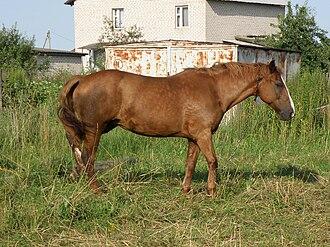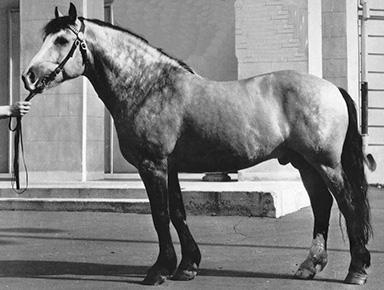
Continent: Europe
Country: Belarus
Weight: 500 – 700 kg
Height: 150 – 156 cm


The Belarusian Draft horse (Biélorusski Tyazhelovoz) originated from crossbreeding efforts undertaken in the late 19th century, involving local light draft-type mares and imported heavy stallions, primarily Ardennais, Percheron, and Brabant.
Selective breeding intensified in the 1920s, driven by Soviet agricultural policies, with the goal of creating a powerful, rustic draft breed well suited to the harsh climate and marshy soils of Belarus.
The national stud-book was gradually organized after World War II, and by the 1950s, a fixed breed type was well established.
Today, the Belarusian Draft is one of the few heavy draft breeds specifically adapted to Eastern Europe, used for agricultural work, horsemeat production, and increasingly for rural tourism.
The Belarusian Draft is primarily bred in Belarus, in lowland regions with a strong agricultural presence. The main breeding centers are located in the following oblasts (provinces):
- Minsk: the central region, historically the heart of organized selection
- Gomel: in the southeast, an area of intensive breeding with large collective stud farms
- Mogilev and Vitebsk: northeastern regions known for high-quality working mares
- Brest: in the west, near the Polish border, with historical cross-border exchanges
- Grodno: more marginally, with a few family-run breeding farms
Breeding takes place mainly in mixed rural farms, state-run reproduction centers, and collective stud farms inherited from the Soviet era.
There are also conservation programs managed by the State Association of Animal Breeding of Belarus, aimed at maintaining genetic diversity and preventing inbreeding.
The breed is occasionally exported or used in crossbreeding programs in neighboring countries such as Russia, Ukraine, and the Baltic States, but remains mostly concentrated within Belarusian territory.
The Belarusian Draft plays a significant role in preserving the bloodlines of heavy draft horses adapted to the harsh climates and wet terrains of Eastern Europe.
Selective breeding has helped fix key traits such as rusticity, pulling strength, high fertility, and long lifespan, making it a reliable breeder in crossbreeding programs aimed at improving the resilience and working capacity of other horses.
This breed has also contributed to the creation or enhancement of local bloodlines in neighboring regions (Russia, Ukraine, the Baltic States), where it is used to improve conformation, docility, and the ability to gain muscle mass quickly, particularly in the context of horsemeat production.
As a regional genetic resource, the Belarusian Draft serves as a strategic reservoir of diversity for European heavy horse breeds, especially in light of the progressive decline of many other traditional draft lines.
Peasant Origins and Initial Crossbreeding:
The Belarusian Draft traces its roots back to the late 19th century in the rural areas of Belarus, then part of the Russian Empire. Farmers primarily used sturdy local mares, well suited to heavy soils and agricultural work. To enhance pulling strength and muscle mass, stallions from Western heavy breeds notably Brabant, Ardennais, and Percheron—were introduced. These crossbreedings laid the foundation for what would become the Belarusian type.
Structuring Under the Soviet Era:
True selective breeding of the Belarusian Draft began in the 1920s–1930s, with the establishment of state breeding stations and collective stud farms under Soviet agricultural planning. The goal was to produce a heavy draft horse that was docile, resilient, and versatile, capable of working in the marshy terrains of Belarus.
After a partial interruption caused by World War II, breeding resumed in the 1950s, supported by the government and leading to the gradual establishment of an official stud book.
Breed Standardization and National Recognition :
Over the decades, a stable breed type was defined: powerful, compact, with a well-developed bone structure and strong musculature, as well as high fertility and early maturity two essential traits for the profitability of collective farms.
In the 1970s and 1980s, the breed was widely promoted across Soviet republics, especially for horsemeat production and agricultural work in less mechanized areas.
Decline and Conservation Efforts :
After the collapse of the USSR in 1991, the Belarusian Draft population suffered a drastic decline. Mechanization, loss of economic outlets, and the dismantling of state structures weakened the breed.
Conservation programs were then launched by the State Association of Animal Breeding of Belarus, with a special focus on genetic diversity, reproductive registration, and the promotion of the breed in modern contexts (tourism, leisure driving, extensive farming, etc.).
A Breed in Transition :
Today, the Belarusian Draft remains a symbolic breed of traditional Belarusian agriculture, while facing the challenge of reinventing its role. The growing interest in rustic breeds, ecological alternatives to tractors, and local equine heritage may offer a path toward the progressive revival of the breed in the years to come.
The Belarusian Draft is known for its calm temperament, natural docility, and ease of handling, even by inexperienced people.
Bred specifically for draft work and use in collective agricultural settings, it was selected for its reliability, patience, and mental stability.
It demonstrates a good learning ability and a willingness to cooperate, making it suitable for both traditional uses (such as plowing and driving) and modern activities like rural tourism or educational demonstrations.
This horse works well in groups, maintains stable behavior in varied environments, and shows a high tolerance for stress, even in noisy or unpredictable situations. It is also appreciated for its calm interactions with other animals, including cattle and dogs.
The Belarusian Draft faces significant challenges due to the increasing mechanization of agriculture and the declining demand for working horses. Like many draft breeds, its population has decreased since the end of the Soviet era.
However, several recent trends suggest encouraging prospects.
On the one hand, the breed benefits from institutional support, notably through conservation programs managed by the Belarusian state and local agricultural organizations. On the other hand, its robustness, docility, and adaptability make it a strong candidate for eco-tourism projects, sustainable animal traction, and ethical horsemeat production.
There is also a growing interest in the Belarusian Draft within educational farms, as well as among private owners looking for rustic horses for leisure driving or historical demonstrations.
In the long term, the survival of the breed will depend on its ability to diversify its uses, the promotion of its genetic qualities, and the development of communication strategies to increase its visibility beyond Belarusian borders.
The Belarusian Draft is generally a hardy and robust breed, selected for its resistance to disease and its ability to thrive in harsh climatic conditions (cold, humidity, heavy soils).
Thanks to its strong bone structure, well-formed hooves, and dense musculature, it presents few orthopedic or locomotor issues under normal breeding conditions.
However, like many heavy draft breeds, it may be predisposed to certain conditions if not properly managed, including:
- Overweight and joint issues (such as arthritis or overload) when overfed without adequate physical activity
- Summer dermatitis or skin irritations in humid areas, especially under the feathering
- Occasional lymphangitis, related to lack of movement or slow venous circulation
- Rarely, minor hereditary defects may appear if inbreeding is not properly controlled
Breeding programs actively monitor these risks through strict reproductive management, regular veterinary checks, and conformational inspections.